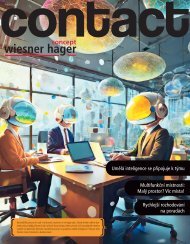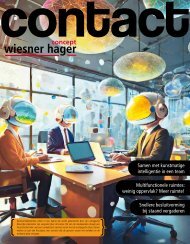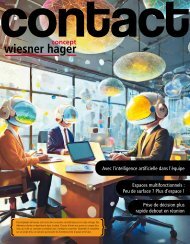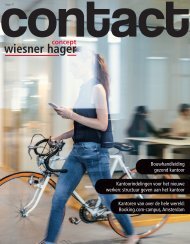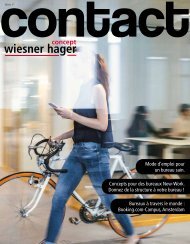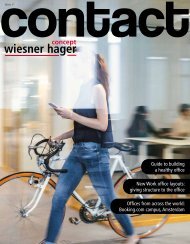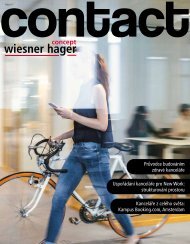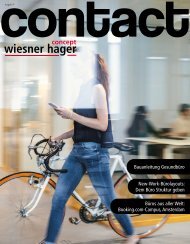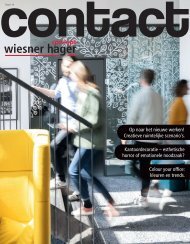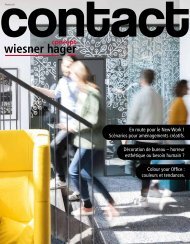contact_office_magazine_#38_EN
Welcome to the latest issue of contact – your trusty companion through the ever-evolving world of work. In this issue, we’re focusing on the topic of artificial intelligence and its influence on office working. Is AI nothing more than a nice assistant, or will it soon become a colleague?
Welcome to the latest issue of contact – your trusty companion through the ever-evolving world of work. In this issue, we’re focusing on the topic of artificial intelligence and its influence on office working. Is AI nothing more than a nice assistant, or will it soon become a colleague?
You also want an ePaper? Increase the reach of your titles
YUMPU automatically turns print PDFs into web optimized ePapers that Google loves.
Trendwatching<br />
Office Life<br />
© Netatmo<br />
Useful ideas for<br />
everyday <strong>office</strong> life.<br />
For fresh air and clear heads: Netatmo’s<br />
smart weather stations for <strong>office</strong> and<br />
home!<br />
Optimise your virtual <strong>office</strong> meetings with<br />
Otter and GenAI.<br />
Otter, the AI-supported meeting assistant that transcribes<br />
audio in real-time, has been taken to the next level with<br />
additional AI features. Using GenAI, it now provides an AI<br />
chatbot that supplies information from previous meetings<br />
recorded with Otter. There is also an AI chat function and<br />
an AI meeting summary that provides an overview of what<br />
was discussed. So you always know what’s happening, even<br />
without the full transcript.<br />
www.otter.ai<br />
Slow down!<br />
From a meeting marathon<br />
to a gentle stroll.<br />
Just finished another day of constant meetings?<br />
Beware. Multiple meetings back-toback<br />
without a break can quickly raise your<br />
stress levels.<br />
We’re all keenly aware that a constant barrage of<br />
meetings doesn’t have much of a positive effect on our<br />
general levels of concentration. Microsoft’s Human<br />
Factors Lab recently carried out a study that measured<br />
peoples’ brainwaves during meetings to determine<br />
their stress levels. The researchers worked with two<br />
different test groups. The first had to have four halfhour<br />
video calls covering different topics on a single<br />
day – back-to-back without a break. The second group<br />
had the same, but with ten-minute gaps between<br />
meetings.<br />
Breaks: The magic bullet.<br />
While the participants’ stress levels<br />
rose and rose during the relentless<br />
meetings, the brief breaks reduced<br />
them to the extent that the subjects<br />
felt a similar amount of motivation<br />
for the last meeting as they did for<br />
the first.<br />
to a new meeting, as the person had to start thinking<br />
about a completely different topic. And during the<br />
meetings, the group who had no breaks were less engaged<br />
and became increasingly withdrawn.<br />
Adding to this stress was having to plan in particularly<br />
challenging, focused tasks between the onslaught of<br />
meetings, all themselves requiring a high degree of<br />
concentration. The better solution here is to combine<br />
simple individual tasks with complex meetings, or<br />
brief and less demanding meetings with tasks that<br />
require greater concentration. A research team at Yale<br />
University also found that online meetings over Zoom<br />
or Teams further fatigue the brain due to the lack of<br />
natural and dynamic interaction between participants,<br />
and feeds dropping in and out and buffering requiring<br />
greater concentration.<br />
So what can you do to stem the negative impacts of<br />
an uninterrupted meeting marathon? If possible, the<br />
recommendation is to not plan in too many meetings<br />
on the same day, and not to rely solely on virtual<br />
meetings. But as this is often impossible to control<br />
or avoid, you need to plan wisely and – above all –<br />
ensure there are breaks. And what’s the best way to<br />
use these breaks? The most important thing is to get<br />
some distance from your desk and work. It also makes<br />
sense to do something that distracts and relaxes you.<br />
Meditating, taking a short walk, small talk,<br />
stretching exercises and getting a bit<br />
of fresh air are just a few examples<br />
of ways we can give our brains a<br />
much-deserved rest.<br />
Source: Research proves your brain needs breaks; Microsoft Human Factors Lab, 2021<br />
Say goodbye to fatigued brains! With the Netatmo<br />
weather station, you’ll always have a clear view of the<br />
air quality and room temperature in your <strong>office</strong>. It<br />
measures data in real-time and presents it clearly in<br />
an app. So you can create the perfect conditions to<br />
work in. The smart weather station helps you find the<br />
perfect time to ventilate the space and keep the <strong>office</strong><br />
at maximum productivity!<br />
www.netatmo.com<br />
© Otter<br />
The highest level of stress was recorded<br />
shortly before the transition<br />
22 <strong>contact</strong><br />
© Freepik<br />
<strong>contact</strong> 23




